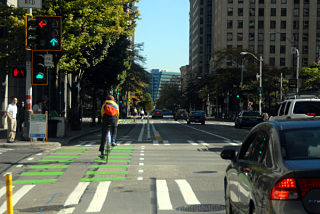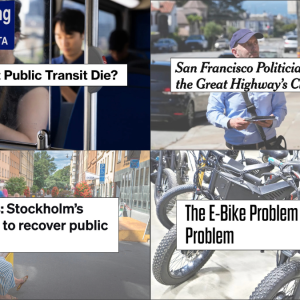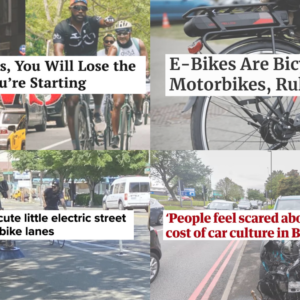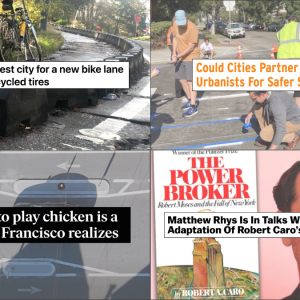Here are the great bike-related links from around the world that caught our eyes this week:
Seattle’s showcase: Downtown Seattle’s new two-way protected bike lane, which replaced a one-way door-zone lane, seems to have immediately tripled bike traffic on the street.
Cop impersonator: In Palo Alto, a man seemingly impersonated a police officer while ordering two kids in a bike lane to ride single file instead of side by side. He then flashed a weapon at one of them.
Anti-theft success: Texas A&M’s four-year-old bike bait program seems to have doubled stolen bike recoveries from 24 percent to 54 percent.
Centerline reform: Double yellow lines increase bike/car friction by seeming to make it illegal to pass a bike, even when it’d be perfectly safe. Iamtraffic is looking for better solutions.
Walking fatality: BikeSnobNYC called for a one-weekend vacation from Strava after a person walking in Central Park was fatally wounded after a collision with a man on a bike.
Road-design lawsuit: The family of a right-hook victim is suing California and Laguna Beach on the grounds that the intersection where she died was designed to look like a “freeway onramp.”
Convicted of lane-taking: A Kentucky single mom who bike-commuted on a highway to save time has been found guilty of reckless driving because she didn’t bike on the rumble strip. She plans to appeal.
Electoral rules: National bike advocates have a useful infographic about the ways nonprofits are and aren’t allowed to get into elections.
Introducing H-bikes: Hydrogen fuel cells (as opposed to electric batteries) haven’t worked with cars yet. But a group of Australians is trying to make them work for bikes.
Nude jerseys: The Colombian Women’s Cycling Team dressed up in racing kits that resembled nude bellies and crotches.
Advertisement
Protected intersection: Vancouver BC is proposing to install a Falbo-style protected intersection.
Speed record: Jens Voigt, 43, pedaled 32 miles in one hour last week, a world record. Velonews has an informative Q&A on the significance.
Mandating gentrification: On-site parking spaces drive up the cost of housing, an affordable-housing advocate from SF argued at the City Club last week. So why does the city require them?
Women biking: Mic.com shares photos of 21 women holding signs about why they ride bikes.
Gender gap explanations: A sign of progress on biking’s gender gap? These days, women’s lower biking rate comes as a surprise to a young female journalist.
Infrastructure vs. behavior: Responding to NYT columnist Timothy Egan’s call for people to start being nicer in response to a “death on a bike,” Brooklyn Spoke argues that the way you actually make this happen is with infrastructure.
Three-foot passing: A new California rule will switch from requiring a “safe distance” for passing bike riders (as Oregon does) to a firm standard: three feet. The state has a cute video to promote the change:
California progress: California’s governor also signed new laws recognizing protected bike lanes as state-approved designs and allowing cities to pay for bike facilities with vehicle surcharges.
Environmentalist prosperity: A major new study has concluded that lower fuel costs, fewer air pollution deaths and lower medical bills might completely offset the short-term economic cost of returning carbon emissions to levels that wouldn’t destroy human civilization.
Bikelash is “a great thing to be dealing with” because it “means we’re forcing difficult decisions,” say an array of smart advocates from around the country (including Portland filmmaker Joe Biel of Aftermass) in a useful new Streetfilm, your video of the week.
If you come across a noteworthy bicycle story, send it in via email, Tweet @bikeportland, or whatever else and we’ll consider adding it to next Monday’s roundup.







Thanks for reading.
BikePortland has served this community with independent community journalism since 2005. We rely on subscriptions from readers like you to survive. Your financial support is vital in keeping this valuable resource alive and well.
Please subscribe today to strengthen and expand our work.
You live near the Columbia. That women’s cycling team is from Colombia.
Yes indeed – thanks.
Looking for a ride to Crater Lake this weekend. Have campsite, will pay gas.
It would be so reassuring if PPB started using bait bikes….
Doing so would first require that they care.
Re: Laguna Beach; I grew up near there; in the 1970’s the Orange County part of PCH could be gridlocked on sunny weekend afternoons–it has been a cyclist-hostile zone for decades. Recently on an organized tour my wife and I were hanging out with an Orange County couple who referred to “about a cyclist killing a month, regularly” in that area. Perhaps organizations like League of American Bicyclists and Adventure Cycling could have a black list of high-hazard cycling areas. Got the spine to do it anyone? I’ll volunteer to write the press releases–I’ll start with our own Oregon coast.
Much writing has been done recently in NYC regarding the rise in intensity of interaction between people biking and people walking on the Central Park parkways. Another person walking there last week, passed away after someone riding, ran into and knocked her to the pavement. Person riding not charged. Second on the parkways this summer.
Said he had the green light. Hardly a defense, given that vehicular traffic is required by law to stop for pedestrians whether it has a green or a red light.
I truly don’t know the NY laws, nor what the intersection looked like where this incident occurred. Hopefully someone can help clear this up for me:
1– was this collision at an intersection where there were traffic signals? Pictures I’ve seen showed a crosswalk across a street, but I don’t recall seeing any traffic signals. Might not have been the same location as the collision
2– is it truly NY law that vehicles have to stop for pedestrians, even if the vehicles have a green light? Is this applied to anywhere, at specific intersections, only in city parks?
As I said, a bunch of stories have been written about the collision, and links to some of them are in the gothamist story, a link to which is included in the Roundup item above. Here’s a link to a NYtimes story I read today:
http://www.nytimes.com/2014/09/20/nyregion/woman-58-in-critical-condition-after-being-struck-by-central-park-cyclist.html?ref=nyregion&_r=1
In one of the gothamist stories, the person riding is said to have claimed he had the green light.
http://gothamist.com/2014/09/20/central_park_cyclist.php
I haven’t read all the stories, so I can’t say with certainty. I don’t doubt at some points along the parkway, there are traffic lights to manage traffic.
Sorry, I haven’t looked through New York’s traffic codes, but I’ll be very surprised if the state or the city doesn’t have a law that requires people using the road with any kind of vehicle, to stop for people crossing the road on foot, green light or not. Vehicles are required to yield to pedestrians. Use of a vehicle can no way be permitted to justify the operator to run down a person on foot. This is a common sense kind of thing the law reinforces.
Tonight I tried to load up the page for New York’s vehicle and traffic code. No luck. Someone else may do better:
http://public.leginfo.state.ny.us/menugetf.cgi?COMMONQUERY=LAWS
it absolutely does not matter whether the cyclist had a “green light.” his speed was inappropriate to the situation.
The several stories I read, report the person riding has yet to be charged for any violation. It was reported that he collided with the lady when he left the bike lane to go around people that were walking there, colliding with her in the main lane, I believe.
It sounds as though the crosswalk was very busy at 4:35 pm in Central Park, and he was trying to cruise through a gap between people walking. Depending upon what statutes New York or the city has, careless or reckless road may be a citation he could be issued.
Says he wasn’t speeding, but his speed may be irrelevant as well as whether or not he had the green. Pedestrians were trying to cross the street. As a road user, on a bike, a vehicle, it was his obligation to yield to them, to stop for them until they could safely pass by. One story reported witnesses saying there was no indication that he braked his bike.
Given that it is perfectly legal to kill pedestrians in the crosswalk with a motor vehicle so long as you are sober, have a valid driver’s license, and remain at the scene, any charges against the cyclist are extremely unlikely as the laws are the same for both. Any attempts at charging a cyclist would be met with a furious 14th amendment challenge. As I pointed out yesterday at one link, this may be the wreck that gets NY to change their vehicular manslaughter laws to cover sober drivers.
Good point. I want to know how reckless was the bicyclist being? Weaving and ducking and dodging through traffic? If that were the case…. then I support a manslaughter charge. I fight for equal rights. Equal is equal. We don’t usually think a bicycle can kill someone, but it did and it can.
I’m squinting at that Seattle bike lane and I’m seeing a “buffer” of paint, but nothing “protected”. Am I seeing it wrong?
You’re seeing a very small portion of it anyway. In most places it’s protected from the main traffic lanes by a row of parked cars. YMMV WRT the level of protection this offers. In the appropriate areas the parking lane is replaced by a left turn lane with separate light signals from the bike lane and crosswalks. There are plastic posts in the buffer.
Regardless of what anyone thinks of its current configuration (could still stand some improvement), it is worlds better than the way it was before, a narrow one way door zone lane separated by traffic lanes by a hands width of paint and no separated signals. It has gone from absolutely harrowing, deadly, possibly the worst piece of installed bike lane in the city in its old configuration to a merely usable piece of infrastructure. Now if you want a thrill to compare to the old 2nd ave bike lane you’ll have to stick with base jumping the needle instead.
Agreed. The only picture with the story is of a buffered bike lane, separated, yes, protected, no.
I characterize bike lanes as adjacent (no separation), separated (buffered from auto or other traffic) and protected (a physical barrier). Barriers can be permeable or impermeable. Parked cars are a permeable barrier – if a vehicle crashes into a permeable barrier (at normal speeds) it is slowed, but may not be stopped, and some form of intrusion into the bike lane may still occur. If a vehicle crashes into an impermeable barrier, the vehicle is stopped.
I find it interesting that many bicycle advocates seem to dismiss the personal economic aspects of the bicycle as transportation. They prefer pushing the environmental and health aspects of the general population, but largely ignore the costs of transportation at a personal level.
I only bring this up because four of the women reference finances directly as a reason they bike. It is twice as many than bring up physical fitness directly, and only one mentions the environmental impact.
Like I have mentioned before, people are more motivated by issues that can easily be seen like personal finances over more abstract and mentally overwhelming issues like climate change. And though I’m not trying to say other motivations for riding bikes aren’t worth discussing or researching, saving vasts amounts of money is something tangible that everyone can relate to.
Saving money is certainly a big benefit of my own bike-riding, though it was never the main reason I started. Until I actually sold my car, the savings weren’t all that fabulous, since the car was long paid-for. Over time, not paying insurance and not having to save up for another car have made a huge difference in my lifestyle (I was able to retire, like, five years early), but younger people, people with kids at home, and people not lucky enough to live centrally might not be swayed by the money-saving aspect, especially if they don’t have a car payment.
I think finances and cost savings of riding comes up all the time on this site.
The health aspects can be directly tied to personal economic aspects– the healthier one is, in theory, the less one will spend on healthcare like doctor visits and medications.
I don’t see a winner between the NYT column and the BS blog post. For the sake of argument, let’s say both of them are wrong.
Whether it is infrastructure or instruction, how much would either one cost and how long would they take to implement?
Paint, signs, and concrete are expensive. The engineering and construction will take decades.
We can start education today. Most of the work can be done before the decade is out. All we need is to make it a requirement to obtain or renew a driver’s license. The cost is a few bucks at registration. That is a tremendous value if it is only a 1% solution. I think it’s better than that.
Re: Right-hook lawsuit. The “free right turn” design that’s so prevalent in California has been a bone in my throat since moving there. My thought on this is it’s a factor in the more recent rise in pedestrian deaths, not only directly due to design in some cases, but in creating new generations of drivers who don’t understand the concept “right turn on red – after stop.” I think it has patterned driver’s to do a more quick and focused glance into oncoming traffic (i.e. cars in the first lane) to optimize their travel. I think drivers – especially in California – have become programmed to expect a right turn as a natural flow of traffic: in the cases where right turns are corked, you’ll notice a tendency of drivers to become quite agitated – often more than those waiting at the red to go straight.
In my opinion, repealing the right-turn-on-red-after-stop law would be, albeit radical, very effective in both reducing pedestrian deaths, and (re-)educating current and new drivers to stop before crosswalks and start seeing more people crossing roadways.
What’s unique about California here? Right turn on red is legal in all US jurisdictions except North Dakota and New York City.
It’s not the law that’s unique to California, it’s the prevalence of roadways designed with right turns as yields instead of merges. With older infrastructures you tend to have no RTO lanes so traffic backs up. In newer locales you tend to have RTO lanes in which the driver is expected to stop, usually before a crosswalk. Then you have ‘expressways’, where there’s typically a triangular island and the right turn isn’t a lane but a curve where the driver can typically maintain speed and is then expected to yield (i.e. the right-turn-on-red-after-stop law doesn’t apply here, I guess…). There are typically no crosswalks in these treatments, and in many cases pedestrians and bicyclists were at an earlier point in time not allowed – though in some cases are now very popular with bicyclists (for the same speed and connectivity they were initially built for cars for).
There are several of these expressways in Santa Clara County, but I can’t think of any with the same design from my travels in Portland/Beaverton/Tigard/Hellsboro. The ‘repeal’ rant was kind of a digression, sorry.
I suspect that at least some of the “bikelash” is not about “forcing hard decisions”. Rather, it could be about the fact that I, as a car-free bicycle owner, don’t pay licensing, insurance or registration fees, and the likely resentment that arises when automobile owners think about that. Whatever. I don’t intend to EVER pay for those things as long as there is no protection or enforcement protecting me on my bicycle in a car-centric landscape; or increased spending and focus on expanding public transit. Automobile owners — and the bicycle lobbyists that kowtow to them — can howl at my stance all they like. The older I get, and the slower the pace of change goes, the less interested I am in playing nice and being patient. I ride a bike because it’s cheaper, it’s a way of thumbing my nose at the auto-petrol/military/plasto-industrial complex, and it’s a lot of fun.
..::ppphhhttt!::..
To citizens who resent that you don’t pay auto licensing, insurance, or registration fees I would ask what child-specific fees they pay to send their children to the same public schools that people without children also pay for (and have no ability to opt out of). American society is not structured around fee-for-use principles, which simply may not be fair to all.
That’s not an infographic.
http://understandinggraphics.com/visualizations/infoposters-are-not-infographics/
Curiously, when I clicked on the link to the article about the police impersonator, I got an ad for “LED Police Strobe Lights”.